
@ShahidNShah


Living with diabetes presents numerous challenges, one of which is an increased risk in developing certain eye conditions. When you think of diabetes, eye health concerns may not be the first thing that comes to mind, but it’s an important aspect to be aware of. Regular eye examinations are highly recommended for individuals who have been diagnosed with diabetes. This is to check for any symptoms of common diabetes related eye conditions such as diabetic retinopathy and diabetic macular edema.
Diabetic retinopathy: This eye condition is one of the most common complications of diabetes. Due to the damage to the blood vessels in the retina due to high blood sugar levels, this condition can lead to vision loss. It’s important to catch diabetic retinopathy early on, as it can progress and lead to vision loss.
Macular edema: This is another severe eye condition related to diabetes. Macular edema involves the swelling and thickening of the macular (the central part of your retina) due to fluid leakage. The leakage is due to damaged blood vessels, this can result in blurry vision and if left untreated, vision loss.
Optical Coherence Tomography (OCT) scans use light waves to create detailed images of the retina. These images are caress-sectional, so eyecare professionals can see the different layers of the retina. OCT scans are a non-invasive technique that allows opticians to detect any changes in your eye health. OCT scans are an effective method in detecting the early onset of various eye conditions and diseases, as well as allowing professionals to monitor the progression of these conditions too.
Regular OCT scans enable early detection and monitoring of diabetes-related conditions such as diabetic retinopathy and macular edema. This early intervention is crucial, as it allows for timely treatment that can prevent or minimise vision loss.
Maintaining good eye health as a diabetic patient requires a proactive approach. Here are some practical tips to help you stay on top of your eye care and help prevent severe cases of diabetes-related eye conditions.
Scheduling regular eye exams with an eye care professional is the best way to prevent diabetes-related eye conditions. Your optician can schedule you in for OCT scans which are effective in detecting and monitoring eye conditions. Monitoring your retina is vital when it comes to detecting the early signs for these conditions.
Maintaining a stable blood sugar level is important for anyone with diabetes. Having a stable blood sugar level can prevent or delay the onset of diabetic eye conditions.The best way to manage your diabetes effectively is by working with your healthcare provider to get the best support and advice.
If you notice any changes to your vision such as blurriness or difficulty seeing clearly at night, you should report these changes to your optician as soon as you can. Your optician can then schedule you in for an OCT scan. This early intervention can make a significant difference in preserving your vision.

Nearly 75% of its clinicians now spend less time working outside of work hours, which has improved provider satisfaction. There's also been a reduction in documentation errors. THE PROBLEM "It is …
Posted Jul 10, 2024 Continuity of Patient Care Generative AI Scheduling - Physician
Connecting innovation decision makers to authoritative information, institutions, people and insights.
Medigy accurately delivers healthcare and technology information, news and insight from around the world.
Medigy surfaces the world's best crowdsourced health tech offerings with social interactions and peer reviews.
© 2025 Netspective Foundation, Inc. All Rights Reserved.
Built on Apr 23, 2025 at 1:08pm